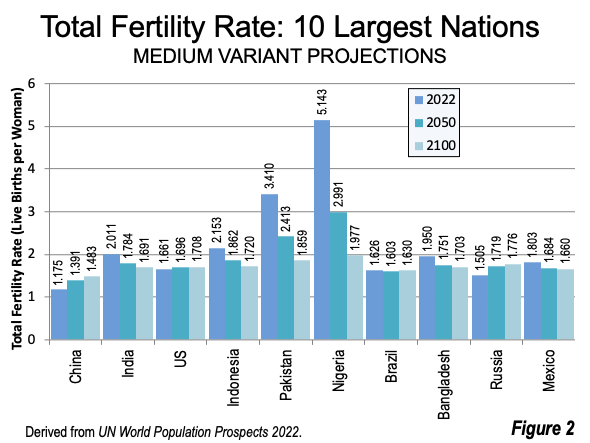
The recently released United Nations World Population Prospects: 2022 forecasts a future with fewer people in 2100 than there were in 2000. This has not happened for a very long time. Under the medium variant, the population would peak at 10.4 billion in 2086, and under the low variant, 7.0 billion, compared to the present population of 7.9 billion. A provided more information on broader trends and compared growth and fertility in more developed and less developed world regions.
Now we will examine the population and total fertility rate (live births per women of childbearing age) from the present through to 2100 for the 10 largest nations in the world. These nations have 57% of the present world population and include (in population order) China, India, the United States, Indonesia, Pakistan, Nigeria, Brazil, Bangladesh, Russia and Mexico.
The UN’s medium variant, is generally considered to be the most likely and is the focus here. The low variant, with its more modest population increase, is also discussed.
Medium Variant: Population
The medium variant suggests that four of the ten nations with the largest populations will have fewer residents at the end of the century than now, China, Brazil, Russia and Mexico. Three would have more, the United States, Pakistan and Nigeria (Figure 1)

China now has the world’s largest population, at approximately 1.43 billion people. China’s population is forecast to decline to 1.32 billion by 2050, and then drop to nearly 50% below its current population by 2100 (771 million).
India is anticipated to reach nearly 1.7 billion residents by 2050 and further expected to reach its peak in 2063, but by 2100, India is also expected to decline to 1.53 billion people in 2100.
The fourth largest country is the United States, with 337 million residents and is expected to increase modestly to 375 million by 2050, and to 394 million by 2100. This increase is expected to occur despite the low US fertility (below), and is related to higher than average international migration.
Indonesia is the fourth largest country at this point it is expected to rise from 275 to 317 million in 2050 dropping back to 287 million in 2100.
Pakistan can be expected to experience substantial growth, from the present 234 million, then rising more than one-half by 2050 to 366 million, and to 487 million by 2100.
Nigeria’s expected population growth is even greater. Starting with a 2022 population of 216 million Nigeria would increase to 375 million by 2050 and 546 million by 2100.
Brazil, with a 2022 population of 215 million would rise to 231 million in 2050, but drop to 185 million by the end of the century. Bangladesh would be more stable, rising from 170 million to 204 million in 2050 and then dropping to 177 million in 2100.
Russia would continue its decline, dropping from 145 million in 2022 to 133 million in 2050 and 112 million in 2100. Mexico would also experience a decline from 127 million in 2022, rise to 144 million in 2050, dropping back to 116 million in 2100.
Median Variant: Total Fertility Rate
Much of the differing population performance of the 10 largest nations can be explained by variations in the total fertility rate (TFR). A TFR of at least 2.1 is required to replace the population (replacement rate). Only three of the ten largest nations now have TFR’s above the replacement rate, with Pakistan and Nigeria far above, and Indonesia which is only slightly above (Figure 2).

China’s current TFR is about 1.18, well below the replacement rate. It is projected that China’s TFR will rise to 1.39 by 2050 and to 1.48 in 2100.
India currently has a TFR of 2.01, just below the replacement rate, and is expected to decline over the century to 1.78 in 2050 and 1.69 in 2100.
The United States has a TFR of approximately 1.66 and is projected to increase modestly to 1.71 in 2100. Indonesia has a TFR slightly above replacement rate and is expected to fall to 1.72 by 2100.
Pakistan has the second highest TFR at 3.41 but is also projected to drop below replacement rate by 2100.
Nigeria has by far the highest TFR among the top 10 nations at 5.14, but is projected to drop below replacement rate to 1.98 in 2100.
Brazil is expected to have a fairly constant TFR at around 1.63 throughout the century.
Bangladesh, which is been one of the world’s poorest nations, has dropped below replacement rate and is expected to drop to 1.70 by the end of the century. Bangladesh seems to be an exception to the general tendency for higher poverty to be associated with greater fertility.
Finally, Mexico would drop from a current TFR of 1.80 to 1.68 in 2050 and 1.66 in 2100.
Low Variant: Population
The low variant, with its lower TFR‘s, anticipates considerable reduction of population in comparison with the medium variant. Only Nigeria and Pakistan are expected to gain population from 2022 to 2100 (Figure 3).

China would drop by nearly one billion residents from 2022 to 2100 to under 500 million. India would drop by more than 400 million, to a population of one billion. The United States would lose more than 60 million and Indonesia would lose about 70 million. Pakistan would gain 90 million and Nigeria would add by far the most new residents, at 160 million by 2100.
In the next century, Brazil would lose nearly 100 million, to 120 million. Bangladesh would drop 60 million to about 110 million. Russia would lose 70 million to a population of 75 million. Mexico would lose 50 million to about 70 million.
Low Variant: Total Fertility Rate
In all ten nations, TFR‘s would drop below the replacement rate by 2100 in the lower variant projections. The principal cause would be the lower TFRs. The highest TFR would be 1.48 in Nigeria (Figure 4).

Conclusion
Of course, there is considerable uncertainty about any projection. But there is plenty of evidence that fertility rates are dropping. Inter-related factors often associated with declining fertility, such as lower poverty rates, greater education and workforce participation among women, higher costs of living and urbanization all seem likely to continue. In the most challenging case, factors such as these could combine to produce results closer to the low variant in the years to come.
Wendell Cox is principal of Demographia, an international public policy firm located in the St. Louis metropolitan area. He is a founding senior fellow at the Urban Reform Institute, Houston, a Senior Fellow with the Frontier Centre for Public Policy in Winnipeg and a member of the Advisory Board of the Center for Demographics and Policy at Chapman University in Orange, California. He has served as a visiting professor at the Conservatoire National des Arts et Metiers in Paris. His principal interests are economics, poverty alleviation, demographics, urban policy and transport. He is co-author of the annual Demographia International Housing Affordability Survey and author of Demographia World Urban Areas.
Mayor Tom Bradley appointed him to three terms on the Los Angeles County Transportation Commission (1977-1985) and Speaker of the House Newt Gingrich appointed him to the Amtrak Reform Council, to complete the unexpired term of New Jersey Governor Christine Todd Whitman (1999-2002). He is author of War on the Dream: How Anti-Sprawl Policy Threatens the Quality of Life and Toward More Prosperous Cities: A Framing Essay on Urban Areas, Transport, Planning and the Dimensions of Sustainability.
Photo: Churchgate Railway Station, Mumbai (by author)












